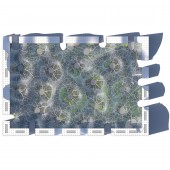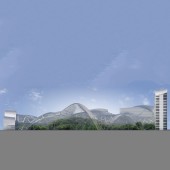Bubbles Biodiversity Park by Rajat Sodhi and Christoph Klemmt |
Home > Winners > #35582 |
 |
|
||||
| DESIGN DETAILS | |||||
| DESIGN NAME: Bubbles PRIMARY FUNCTION: Biodiversity Park INSPIRATION: The geometry of the structural system has been generated using an algorithm which simulates the development of veins in leaves or butterfly wings. The heating and cooling of the air is done through a ground source heat exchange system. Electricity for the project can be generated by solar cells integrated into the canopy surface. UNIQUE PROPERTIES / PROJECT DESCRIPTION: As a response to the bad air quality which is affecting many cities in developing countries like India and China, Orproject proposes the construction of an enclosed park within the city. The park houses a botanical garden, the air inside the park is filtered, and temperature and humidity are controlled throughout the year. The buildings surrounding the park, which are connected to the controlled air system, can house apartments, offices and retail, but may also offer sports or medical facilities which make specific use of the healthy air. OPERATION / FLOW / INTERACTION: The outside air is filtered and conditioned via a ground source heat exchange system and then pumped into the botanical garden. The plants in the garden will additionally help to clean the air. The general public is invited to use the garden for education and recreation. The adjacent building are directly connected to the clean air system and the occupants benefit from the healthy environment. PROJECT DURATION AND LOCATION: The project is a self-initiated proposal to improve the quality of life for people in cities with bad air. |
PRODUCTION / REALIZATION TECHNOLOGY: The surface of Bubbles is made using ETFE panels SPECIFICATIONS / TECHNICAL PROPERTIES: ETFE is a type of polymer foil which is used to manufacture translucent pillows. Those pillows are light weight and reduce the weight and cost of the overall structure. Solar shading and photovoltaic cells can directly be integrated into the EFTE surface. TAGS: Bubbles, Orproject, Biodiversity Park, ETFE, Biomimicry RESEARCH ABSTRACT: The research involved abstracting nature's rules around venation growth in leaves or insect wings. A team from Calgary University proposed an algorithm which was developed and used for our application to create a light-weight structural system. The research analyzed how similar patterns evolve in nature, what drives those patterns, and how to simulate them algorithmically. Other research involved identifying materials for ideal ecologic and lasting construction for the bubble surface. Passive energy and air filtering systems were researched to devise a suitable MEP system for the project. We proposed to use integrated solar cells to power air supply and ground source heat exchange systems. CHALLENGE: The biggest design challenge was to make an economically feasible proposal. The structure covers a large area with a transparent enclosure, therefore the task was to achieve functionality and affordability. We achieved this by taking a bio-mimetic approach and looked at light-weight natural structures and identified leaves and butterfly wings. Both are thin, flat surfaces that provide structural support against large forces. Nature achieves this by growing different density of venation networks to absorb these forces. Inspired by this, we developed growth simulations of similar structures, with the aim of generating efficient light-weight systems. The pattern on our surface grows in a similar way and results in an efficient and affordable structural system. ADDED DATE: 2014-06-29 02:19:48 TEAM MEMBERS (2) : Christoph Klemmt and Rajat Sodhi IMAGE CREDITS: Image 1: Orproject, 2014 Image 2: Orproject, 2014 Image 3: Orproject, 2014 Image 4: Orproject, 2014 Image 5: Orproject, 2014 |
||||
| Visit the following page to learn more: http://orproject.com/bubbles/ | |||||
| AWARD DETAILS | |
 |
Bubbles Biodiversity Park by Rajat Sodhi and Christoph Klemmt is Winner in Urban Planning and Urban Design Category, 2014 - 2015.· Read the interview with designer Rajat Sodhi and Christoph Klemmt for design Bubbles here.· Press Members: Login or Register to request an exclusive interview with Rajat Sodhi and Christoph Klemmt. · Click here to register inorder to view the profile and other works by Rajat Sodhi and Christoph Klemmt. |
| SOCIAL |
| + Add to Likes / Favorites | Send to My Email | Comment | Testimonials | View Press-Release | Press Kit |
Did you like Rajat Sodhi and Christoph Klemmt's Urban Planning Design?
You will most likely enjoy other award winning urban planning design as well.
Click here to view more Award Winning Urban Planning Design.








